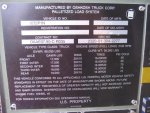The two share the same parking brake, transfer case, and transmission shift levers, although a civilian Hummer receives vinyl-covered, padded interior panels to gussy it up a bit. The parking brake lever is military-inspired and offers a very positive engagement. Adjusting the parking brake is done by simply turning the knob at the top. All Hummers have full-time four-wheel drive, so the positions in both versions are marked H (High), HL (High Loc), N (neutral), and L (Low-Loc). Interestingly, there is no Park position on the military versions, and we’re told the civilian Hummers are the first to have Park. In order to start any Hummer without a Park position, it’s necessary to set the parking brake and shift the tranny into Neutral. No manuals are available in either version.
Everything under the hood is pretty much the same when comparing the civilian and military 6.2L diesel engines. However, there are a few notable exceptions. Military Hummers don’t have air conditioning, run on a 24-volt electrical system, and have a giant generator hanging off the engine. For those equipped with a central tire-inflation system (optional on both the civilian and the military Hummers), the compressor and solenoids are located on the driver-side fenderwell. Civilians have the option of a GM 6.5L diesel, a 6.5L turbodiesel, or a 5.7L gas engine.
The fiberglass hoods are interchangeable between the two versions, right down to the mounting pad for the blackout light (the blackout light is absent on the civilian Hummer, of course). The military version has different parking and taillights, and the lighting system actually has two blackout stages. The first stage leaves the lower portion of the two parking lights and taillights illuminated, while the full blackout only illuminates a single small light on the front that’s about the strength of a small flashlight bulb. This light enables the driver to see about 40 feet ahead of the truck with the aid of military-spec night-vision goggles.
The military uses several different bodies on the Hummer, including an ambulance, a light-duty cargo carrier, a light-duty passenger carrier, and a heavy-duty cargo carrier. Civilian models are also available in a variety of styles, including a two- or four-door hardtop, a two- or four-door soft top, and a four-door wagon. Both military and civilian Hummers have a 1-1/4-ton rating.
Both styles use the same suspension and drivetrain designs. The suspension is independent front and rear and sprung with coils at each wheel, which yields an impressive 16 inches of ground clearance in the center of the vehicle. However, we noted wheel travel is limited, especially when compared to conventional straight-axle designs. The Hummer features 1.92:1 gear reduction units at each wheel, which is technology borrowed from heavy-duty trucks. By using these reduction units at the extreme end of the driveline, it’s possible to use smaller and lighter components throughout the rest of the drivetrain. Also, instead of having the brakes at each wheel like most vehicles, the Hummer’s all-disc brakes are located at the end of the differential assembly on the upper portion of the axleshafts. The only difference between the two models is different spring rates and shock valving, which also vary according to the body.



